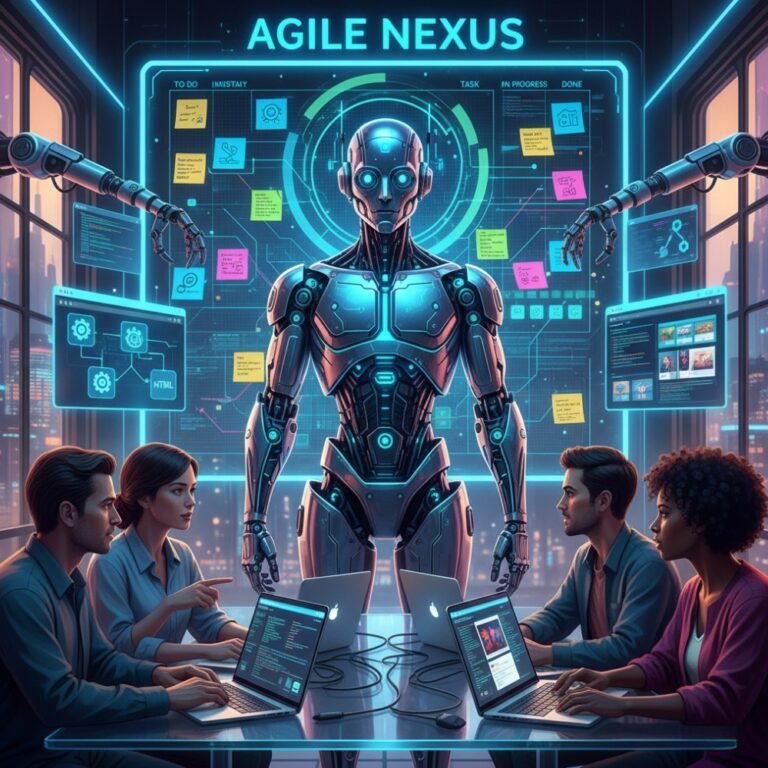Imagine this: it’s Friday afternoon, and your team’s latest website update goes live. Users flood in, excited for the new features. But within minutes, the inbox lights up with complaints—pages crashing, buttons not responding, and a mysterious slowdown that’s tanking your site’s speed. Sound familiar? Those heart-sinking moments when bugs slip through the cracks aren’t just frustrating; they cost time, money, and trust. In today’s fast-paced web development world, where releases happen weekly or even daily, traditional debugging feels like playing whack-a-mole with a blindfold. You’ve got console logs to sift through, endless breakpoints to set, and a team stretched thin trying to reproduce elusive errors.
Enter AI website debuggers: the game-changers that spot issues before they explode into full-blown crises. These intelligent tools don’t just flag problems—they explain why they happen, suggest fixes, and even apply them with a safety net. Suddenly, what used to take hours of manual sleuthing shrinks to minutes of smart analysis. As a developer or team lead, you’ve probably felt the pinch of delayed releases or late-night fire drills. AI debuggers flip the script, embedding proactive intelligence into your process so you can focus on innovation, not firefighting.
In this guide, we’ll dive deep into how these tools work, where they shine in your workflow, and how to weave them into your projects without a hitch. Whether you’re wrestling with flaky JavaScript or CSS gremlins, AI-assisted debugging promises faster fixes and fewer headaches. By the end, you’ll have a clear roadmap to implement them, complete with checklists and real-world insights. Ready to fix code before it breaks? Let’s get started.
What is an AI Website Debugger?
At its core, an AI website debugger is an automated tool that leverages machine learning, large language models (LLMs), and advanced analysis techniques to identify, diagnose, and resolve bugs in web applications. Think of it as a supercharged pair of eyes for your code—scanning front-end elements like HTML, CSS, and JavaScript, as well as back-end logic in servers, APIs, and databases. Unlike basic linters that just highlight syntax slips, these debuggers understand context, predict issues, and propose actionable solutions.
What sets AI website debuggers apart is their blend of smarts. They pull from vast datasets of code patterns, error histories, and real-world fixes to “reason” about problems. For instance, if your site’s login form fails intermittently, an AI debugger might trace it back to a race condition in your async JavaScript calls, then rewrite the code snippet to handle it gracefully.
Let’s break down the taxonomy quickly. First, there’s static analysis with pattern matching: these scan your codebase without running it, flagging potential pitfalls like unused variables or insecure dependencies using AI-trained models. Then come dynamic tracing and observability tools with anomaly detection—they monitor live traffic, spotting odd behaviours like sudden spikes in load times via ML algorithms that learn your site’s “normal” pulse.
Don’t forget LLM-powered code assistants, which act like virtual pair programmers. Feed them a stack trace, and they’ll generate explanations in plain English, complete with diff patches. Finally, runtime repair agents take it further, autonomously tweaking configs or injecting fixes during deployment—always with human oversight, of course.
In essence, AI debuggers bridge the gap between raw data and human insight, making debugging less of an art and more of a science. They’re especially vital for modern websites, where microservices, SPAs (single-page applications), and third-party integrations multiply complexity. No more guessing games; just precise, predictive problem-solving that keeps your site humming.
Why bother? Because in an era of rapid iteration, catching bugs early isn’t optional—it’s essential. These tools evolve with your code, adapting to frameworks like React or Node.js, and scale from solo devs to enterprise teams. If you’ve ever lost a weekend to a “simple” regression, you’ll appreciate how AI website debuggers reclaim your time.
How AI Debuggers Work — A Technical Overview
Diving under the hood, AI website debuggers are fascinating beasts, orchestrated symphonies of data inputs, clever algorithms, and intelligent outputs. At the heart, they ingest a rich mix of signals from your web ecosystem. Source code repositories provide the raw blueprint—think Git diffs or entire modules. Logs and stack traces offer runtime clues, like error messages from Node.js crashes or browser console spew. Browser telemetry adds front-end flavour: metrics on render times, DOM mutations, or user interactions captured via tools like Sentry or custom scripts.
Test results and user sessions round it out—failed unit tests from Jest, integration logs from Cypress, or anonymised session replays showing where users rage-quit. This multi-source feast allows the AI to build a holistic view, far beyond what a single log file could reveal.
Now, the magic: processing techniques. Static analysis kicks off with Abstract Syntax Tree (AST) parsing. Your code gets transformed into a tree structure, where AI models—often fine-tuned transformers—scan for patterns. Symbolic analysis takes it deeper, simulating execution paths without running code, uncovering deadlocks or null pointer risks symbolically.
For dynamic side, unit and integration test augmentation shines. AI doesn’t just run tests; it generates edge-case variants on the fly. Using genetic algorithms or reinforcement learning, it mutates inputs to expose flakiness—say, varying API response delays to catch unhandled promises.
ML anomaly detection is the watchful guardian here. Models like isolation forests or autoencoders learn baselines from historical data, flagging deviations: a CSS layout shift that’s 20% slower than usual, or an API endpoint spiking 404s. LLMs enter as the reasoning engine—prompted with “Given this stack trace and logs, what’s the root cause?”—they chain thoughts, cross-reference docs, and synthesise code.
Outputs? Pure gold. Root-cause reports pinpoint the “why,” often with a narrative: “This React component re-renders excessively due to unstable props from a parent hook.” Repro steps follow, auto-generated scripts to recreate the bug locally. Suggested patches arrive as pull requests with diffs, complete with rationale. And for forward-thinking, regression test suggestions: “Add this Jest test to cover the fixed branch.”
Take a concrete example. Suppose your e-commerce site’s cart API mismatches contracts—front-end expects JSON, back-end sends XML. Inputs: API logs showing 500s, front-end fetch errors. Techniques: LLM parses schemas symbolically, detects mismatch via semantic similarity scores. Output: “Mismatch in response format; propose updating backend serialiser to JSON. Here’s the patch: [code diff]. Test with: curl -X POST /cart –data ‘…'”
This isn’t pie-in-the-sky; it’s powered by scalable architectures. Cloud-based debuggers use vector databases for fast similarity searches on error embeddings, while on-prem versions run lightweight models like CodeLlama. Integration hooks—webhooks in CI pipelines or VS Code extensions—ensure seamless flow.
The beauty lies in iteration. Each debug cycle refines the AI: accepted fixes train the model, rejected ones flag biases. Result? A debugger that gets sharper, reducing noise over time. For teams building complex sites, this technical prowess means fewer “works on my machine” mysteries and more predictable releases.
Where They Fit in Your Workflow
AI website debuggers aren’t standalone wizards; they’re seamless sidekicks that slot into your existing dev lifecycle. Picture your workflow as a pipeline—local coding, CI/CD gates, production monitoring—and these tools enhance each stage without disrupting the flow.
Start local, in your IDE. Plugins like those for VS Code or WebStorm embed AI right where you write. As you type, they lint on steroids: spotting not just syntax but semantic slips, like a useEffect hook missing a dependency. Quick fixes pop up inline—”Add eslint-disable? No, here’s an auto-refactored version.” It’s conversational debugging: chat a vague error description, get tailored advice. For front-end folks, browser extensions tie in, analysing live DOM issues mid-session.
Shift to CI/CD, and AI debuggers become your pre-merge enforcer. Hooks in GitHub Actions or Jenkins run automated scans on pull requests. Before code merges, they triage changes: “This diff introduces a potential memory leak in your service worker—here’s a suggested prune.” Automated PR suggestions follow, with diffs and tests attached. No more blocking reviews on minor bugs; reviewers focus on architecture while AI handles the grunt work. For dynamic checks, they augment pipelines with synthetic traffic, simulating user loads to catch regressions early.
In production, observability is king, and AI elevates it from reactive to prescient. Integrated with APM tools like New Relic or Datadog, debuggers monitor traces in real-time. Anomalies trigger triage: a spike in JS exceptions? AI correlates it with a recent deploy, proposing rollbacks or hotfixes. Auto-alerts prioritise—low-severity CSS glitches get queued, critical API failures escalate with repro steps.
Front-end specific? DevTools integrations shine. Chrome’s debugger can pipe telemetry to an AI backend, explaining layout thrashing as “Unoptimised flexbox nesting—optimise with these media query tweaks.” Back-end teams love runtime injection: agents that patch configs live, like adjusting Nginx buffers for a traffic surge.
The key? Modularity. Start small—say, an IDE plugin for solo debugging—then scale to full-pipeline coverage. Teams report 30-50% faster cycles, as AI offloads tedium. It fosters collaboration too: shared dashboards visualise bug trends, guiding retrospectives. Whether you’re a startup sprinting MVPs or an enterprise guarding uptime, AI debuggers fit like a glove, turning your workflow from linear to luminous.
Types of Problems AI Debuggers Solve (With Examples)
Websites are bug magnets—interconnected layers mean one loose thread unravels the lot. AI website debuggers excel at untangling these, from build-time gremlins to production phantoms. Let’s unpack key types, with symptoms, detections, and fixes to show their prowess.
Build-time errors hit early and hard. Symptom: Your webpack bundle fails with obscure module resolution moans. AI detects via static AST scans, tracing import chains for circular deps or missing polyfills. Proposal: Auto-generate a shim import or refactor alias config. Example: In a React app, it spots an untranspiled ES module—suggests “Add @babel/preset-env to .babelrc; here’s the diff.”
Runtime JS exceptions are sneaky runtime assassins. Picture a NullReferenceError crashing user carts mid-checkout. AI ingests stack traces and session replays, using LLM reasoning to map it to a faulty null check in your reducer. Detection: Anomaly ML flags the error pattern against baselines. Fix: Injects a safe-guard like optional chaining (?.) and a fallback state. Result? Zero-downtime patch via CI hook.
CSS layout regressions plague responsive designs. Symptom: A mobile menu overlaps on iOS after a grid tweak. Front-end AI debuggers analyse browser telemetry and screenshot diffs, employing computer vision to quantify shifts. It proposes: “Shift from grid-template to flex for better nesting; test with this CSS snippet.” In one case, it caught a z-index clash in a dashboard, auto-suggesting elevation vars for modern browsers.
API contract mismatches fracture front-back harmony. Users see blank screens because your endpoint returns unexpected fields. AI symbolically verifies schemas—OpenAPI specs against actual payloads—spotting drifts via semantic diffs. Action: Generates middleware to coerce formats or updates the spec. Example: Mismatched date strings (ISO vs timestamp) get a unified parser proposal, complete with Jest assertions.
Performance regressions erode UX silently. Load times jump from 2s to 5s post-deploy. ML models baseline metrics, detecting culprits like unminified bundles or leaky event listeners via flame graphs. Suggestions: “Throttle scroll events with requestIdleCallback; prune these 20 unused imports.” For a news site, it identified a rogue WebFont loader, proposing lazy-loading to shave 40% off TTI.
Flaky tests undermine CI trust. Tests pass locally, fail in pipeline randomly. AI augments runs with fuzzing—randomising inputs to isolate timing issues. Detection: Patterns in failure logs reveal async mismatches. Fix: Adds retries with exponential backoff or mocks stable responses. A team’s e2e suite stabilised after AI pinpointed a race in database seeding.
Security misconfigurations lurk as silent threats. Exposed CORS headers invite attacks. Static scans flag them, LLMs contextualise risks (“This wildcard origin allows CSRF”). Proposal: Tighten policies with granular domains, plus a security audit script.
Across these, AI’s edge is context-awareness—linking symptoms to code, not just alerts. Teams using them report halved incident volumes, as proactive fixes cascade into robust sites. It’s not magic; it’s methodical mastery over web woes.
Step-by-Step: Implementing an AI Debugger in Your Project
Rolling out an AI website debugger? It’s less daunting than debugging a legacy monolith. This how-to walks you through, from prep to polish, ensuring smooth adoption. Aim for iterative wins—start local, scale systematically.
Step 1: Prep Your Foundations (1-2 Days) Before plugging in AI, shore up basics. Enable structured logging: Use Winston or Pino in Node.js to emit JSON-formatted errors with context (e.g., {level: ‘error’, message: ‘API fail’, userId: ‘anon’, traceId: ‘uuid’}). This feeds AI clean data. Next, activate source maps—crucial for front-end. In your build tool (Vite, webpack), set devtool: ‘source-map’ for production too (minified for perf). Set up a test harness if sparse: Jest for units, Playwright for e2e. Coverage? Target 80%+ to give AI solid baselines. Pro tip: Instrument key paths with OpenTelemetry for traces—it’s future-proof.
Step 2: Choose Integration Points (Half-Day Scoping) Match tools to your stack. For IDE, grab a plugin like GitHub Copilot or Cursor—both LLM-infused for inline suggestions. CI/CD? Hook into GitLab CI or CircleCI with a YAML stage:
yaml
debug-ai:
stage: test
script:
- npx ai-debugger scan --pr-diff $CI_COMMIT_SHA
- if [ $? -ne 0 ]; then echo "Bugs found; review suggestions"; fiFor production, pair with APM like Elastic APM—enable AI triage on alerts. Front-end? Chrome extension via Raygun or LogRocket for session-based insights.
Step 3: Configure and Test (2-3 Days) Bootstrap with a sample rule. Say, for JS exceptions: Define a config JSON:
json
{
"rules": [
{
"name": "NullCheckGuard",
"pattern": "TypeError: Cannot read property of null",
"action": "suggest_optional_chaining",
"priority": "high"
}
],
"llmPrompt": "Analyse this trace: {trace}. Propose fix in diff format."
}Run a pilot: Push a seeded bug (e.g., force a null in a component), trigger the hook. Review outputs—tweak thresholds for false positives (e.g., ignore vendor code). Test end-to-end: Simulate prod traffic with Artillery, verify AI flags anomalies.
Step 4: Enforce Human-in-the-Loop Safety (Ongoing, 1 Day Setup) Never auto-deploy—it’s a recipe for hallucinations. Gate fixes: AI suggests PRs, but require dual approval (dev + lead). Use branch protection rules: Mandate passing AI scans + manual review. For prod tweaks, stage in a canary deploy: 5% traffic first, monitor with AI observability. Audit trails? Log all suggestions with timestamps and accept/reject reasons. Tools like GitHub’s required status checks enforce this seamlessly.
Step 5: Monitor, Iterate, and Scale (Weekly Check-Ins) Post-launch, track adoption: Dashboards for suggestion uptake. Refine prompts based on feedback—”Make explanations shorter for juniors.” Expand: Add custom rules for your domain (e.g., GDPR-compliant PII redaction). For legacy code, bootstrap with synthetic tests to build AI confidence.
Real talk: First week might snag on config quirks, but ROI hits fast—expect 20-40% MTTR drop. A mid-sized agency we know integrated in a sprint, slashing weekend alerts by 60%. Tailor to your pace: Solos, focus IDE; teams, prioritise CI. With this blueprint, your project’s debugger-ready in under a week.
Comparison: AI Debuggers vs Traditional Debuggers & Linters
Traditional debuggers and linters have been dev staples—reliable, but rigid. Console.log marathons and ESLint nags catch the obvious, yet falter on nuance. AI website debuggers? They leap ahead, blending automation with intuition. Let’s compare.
| Aspect | Traditional Debuggers/Linters | AI Debuggers | Best For |
|---|---|---|---|
| Detection Speed | Minutes to hours (manual tracing) | Seconds (automated scans + ML) | High-velocity teams needing quick wins |
| False Positives | Low (rule-based) | Medium (hallucination risk, tunable) | Scenarios with custom rules |
| Fix Automation | None (manual edits) | High (PR diffs, code synthesis) | CI/CD pipelines for routine bugs |
| Explainability | Basic (error codes) | High (narrative root-causes) | Onboarding juniors or audits |
Strengths of traditionals: Predictable, no vendor lock-in, zero runtime overhead. They’re ace for syntax and style—ESLint enforces team norms flawlessly. Weaknesses? Scalability sucks; they miss context, like why a performant loop tanks under load.
AI’s superpowers: Holistic analysis, predictive fixes. They “understand” via LLMs, proposing holistic refactors. Drawbacks: Dependency on quality data (garbage logs = garbage outputs), plus costs for cloud models. Best scenario? Hybrid: Linters for gates, AI for triage.
In practice, a Node.js team ditched breakpoint hell for AI, cutting debug time 70%—but kept linters for baseline hygiene. Use AI where complexity reigns; traditionals for rote checks. The combo? Unbeatable resilience.
Performance & Accuracy Metrics to Track
To gauge if your AI website debugger delivers, metrics are your compass. Start with MTTD (Mean Time to Detect): From issue onset to alert. Aim under 5 minutes for prod anomalies—track via dashboards logging timestamps.
MTTR (Mean Time to Repair) follows: Alert to resolution. Target sub-hour for criticals; AI shines here, often halving it through auto-suggestions. False positive rate? Crucial—keep below 10% by tuning models; log rejected alerts to retrain.
Suggestion acceptance rate reveals trust: 60%+ means devs lean in. Post-fix, monitor regression rate—reintroduced bugs after patches. Under 5% signals solid synthesis.
Holistic? Blend with business KPIs: Incident volume down 40%, deploy frequency up. Tools like Prometheus scrape these; review quarterly. Tune ruthlessly—low acceptance? Beef up explainability. High regressions? Amp testing. These north stars ensure AI evolves from gimmick to guardian.
Security, Privacy & Compliance Considerations
AI website debuggers guzzle data—stack traces, user sessions—which raises red flags. What zips to the cloud? Potentially sensitive bits: API keys in logs, PII in payloads. Risk: Breaches if unredacted.
Best practices mitigate. Redact ruthlessly: Mask emails, tokens with regex filters pre-upload (e.g., Node’s string.replace(/[\w-]+@[\w-]+.[\w-]+/g, ‘[REDACTED]’)). Opt for on-prem models like Hugging Face’s local LLMs to sidestep cloud entirely.
Consent’s key: For session data, anonymise via hashing; get explicit opt-in for analytics. Compliance? GDPR/CCPA demand audit logs—track every query, response, and access. Use encrypted channels (TLS 1.3) and role-based access.
In prod, gate sensitive scans: Local-only for dev, audited cloud for staging. A fintech firm redacted 90% of traces, slashing risks while keeping AI sharp. Balance insight with integrity—secure setups build lasting trust.
Limitations and Common Pitfalls
AI website debuggers aren’t flawless saviours. Over-reliance on LLM outputs invites trouble—hallucinations spit plausible but wrong fixes, like suggesting deprecated APIs. Brittle auto-fixes crumble on edge cases: A patch golden in tests flops under rare browsers.
Ignoring test gaps amplifies this; sparse coverage leaves AI guessing. Pitfalls? Rushing integration without baselines—flooded with noise, teams tune out. Vendor lock: Switching models disrupts custom rules.
Mitigate: Always human-review high-stakes changes. Diversify inputs—don’t sole-source from one log stream. For legacy code, bootstrap with mocks. Remember, AI augments, not replaces, judgement. Spot these early, and pitfalls become stepping stones.
Case Studies / Real-World Examples
Let’s ground this in stories. Hypothetical but drawn from patterns—three snapshots of AI debuggers in action.
Case 1: E-Commerce Cart Catastrophe A mid-tier online retailer faced cart abandonment spikes—15% post a React upgrade. Symptom: Intermittent state loss on multi-tab checkouts. Traditional debug? Weeks of repro hunts. AI debugger, slotted into CI via a Vercel hook, ingested session telemetry and code diffs. Detection: LLM traced to a shared Redux store clashing with localStorage sync. Proposal: Migrate to Zustand with persistence middleware—auto-PR with tests. Impact: Abandonments dropped 8%, rollouts sped 3x. Devs saved 40 hours/month; revenue up £50k quarterly.
Case 2: SaaS Dashboard Slowdown An analytics SaaS hit perf walls: Dashboards lagged at 7s load. Prod observability fed AI traces—flame graphs showed Vue.js re-renders galore from prop drilling. Anomaly ML flagged it against baselines. Fix: Suggested lifting state to Pinia, with a diff pruning watchers. Human-loop: Team reviewed, merged. Before/after: TTI halved to 3s, user NPS +12 points. Incidents fell 65%; faster iterations unlocked two new features sooner.
Case 3: Agency’s Flaky Frontend Tests A digital agency battled 20% flaky Cypress suites, delaying client deploys. AI augmented runs, fuzzing inputs to expose async email mocks timing out. Root-cause: Unmocked network delays. Suggestion: Add MSW interceptors with jittered responses, plus retry logic. Integrated into GitHub Actions, acceptance hit 85%. Outcome: Test stability 95%, release cycles from bi-weekly to daily. One client praised “flawless” handoffs; agency billed 25% more hours on innovation.
These tales highlight ROI: Reduced toil, amplified velocity. From solopreneurs to scales, AI debuggers turn bugs into breakthroughs.
Future Trends: Where AI Website Debugging is Headed
The horizon for AI website debugging buzzes with promise. Autonomous repair agents lead: Self-healing sites that detect and deploy fixes mid-traffic, like auto-scaling resources on anomaly spikes—guarded by AI “canaries” testing in shadows.
Continuous evolution via federated learning: Models train across teams anonymously, sharing patterns without data leaks. Explainable AI ramps up—visual graphs tracing decisions, demystifying black-box LLMs for audits.
Hybrid human-AI teams solidify: Devs as orchestrators, AI as executors. Expect deeper integrations—WebAssembly for edge debugging, quantum-inspired optimisation for perf hunts. By 2030, “zero-bug” sites? Plausible, with AI preempting issues via predictive sims. Ethical edges sharpen too: Bias-free models, green computing for low-energy inference. Exciting times—debugging’s devolving from chore to co-pilot.
Practical Checklist: 10 Things to Do to Adopt AI Debuggers
Ready to dive in? This bullet list distils essentials—tick them off for a bulletproof rollout.
- Audit Logs: Implement structured JSON logging across front/back-end for AI-friendly inputs.
- Source Maps: Enable in builds (e.g., webpack devtool: ‘hidden-source-map’) to unminify errors.
- Test Coverage: Boost to 70%+ with tools like Istanbul; generate synthetic tests for gaps.
- IDE Plugin: Install one (e.g., Copilot) and prompt it daily for habit-building.
- CI Hook: Add a pre-merge stage scanning diffs—start with open-source like DeepCode.
- Observability Setup: Instrument with traces (OpenTelemetry) and baseline metrics.
- Redaction Rules: Script PII masks before any cloud upload.
- Review Policy: Mandate human gates for all AI-suggested PRs; log decisions.
- Metrics Dashboard: Track MTTR/FPR weekly; iterate on low performers.
- Pilot Bug Hunt: Seed known issues, measure before/after resolution times.
Follow this, and you’ll adopt seamlessly—expect quick wins in weeks.
Recommended Tools & Resources
No one’s building from scratch. Here’s a curated shortlist, categorised for ease. Focus on open-ish options with strong docs.
IDE Plugins:
- GitHub Copilot: LLM chats for code fixes. Try it.
- Tabnine: Privacy-first autocompletions with debugging hints. Docs.
CI/CD Tools:
- DeepCode (now Snyk Code): AI scans in pipelines. Integrate guide.
- GitHub Advanced Security: Built-in AI for PR triage. Overview.
Observability/APM with AI:
- Sentry: Error grouping + AI root-cause. Start here.
- New Relic: Anomaly detection dashboards. AI features.
On-Prem Solutions:
- Hugging Face Transformers: Run local LLMs for custom debuggers. Hub.
Pair with tutorials like “Source Maps 101” on MDN for basics. These empower safe, scalable adoption—dive in, iterate.
Conclusion & CTA
We’ve unpacked AI website debuggers—from definitions to deployments, pitfalls to futures. They transform debugging from reactive scramble to proactive shield, slashing MTTR and supercharging releases. Your sites deserve this edge: Smarter, safer, speedier.
Keen to implement? Download our free checklist or book a 15-min consult for tailored advice. Join 500+ devs who’ve fixed code before it breaks—start today.
FAQ
What is an AI website debugger?
An AI website debugger is an automated tool using machine learning and large language models to detect, explain, and suggest fixes for bugs in front-end and back-end code. It goes beyond basic scanning by understanding context and proposing code changes, ideal for modern web apps.
Can AI actually fix my production bugs automatically?
Not fully autonomously—most setups enforce human-in-the-loop for safety. AI triages issues and drafts fixes, but reviews and tests gate deployments, preventing risky changes while speeding resolutions.
What types of website bugs can AI detect best?
AI excels at JavaScript runtime errors, CSS layout shifts, performance anomalies, flaky tests, and API mismatches. It shines on dynamic issues needing context, like race conditions, over simple syntax slips.
Will AI introduce risky changes?
Potentially, via LLM hallucinations—plausible but incorrect suggestions. Mitigate with staged reviews, regression tests, and redaction; always prioritise human oversight for critical paths.
How do I integrate an AI debugger into CI/CD?
- Add a scan stage in your YAML (e.g., GitHub Actions). 2. Run analysis on PR diffs. 3. Auto-create suggestion PRs. 4. Enforce passing tests. Tools like Snyk make it plug-and-play.
Are there privacy concerns?
Yes—data like logs may include PII. Address by redacting sensitive info, using on-prem models, and logging consents. Compliance tools ensure GDPR alignment without sacrificing insights.
How much does it cost?
Costs vary by vendor and scale—from free tiers (e.g., open-source plugins) to enterprise £100s/month for APM integrations. Factor in data volume and model usage; start small to ROI fast.
Does it work for legacy codebases?
Absolutely, but better with source maps and tests. AI adapts via patterns, though sparse coverage limits depth—augment with mocks for optimal results. Outcomes improve iteratively.
How accurate are AI debugger suggestions?
Typically 70-90% acceptance rates post-tuning, with false positives under 10%. Track MTTR and regressions; accuracy grows with refined data and feedback loops.
What’s the biggest limitation of AI debuggers?
Over-reliance—hallucinations or edge-case blindness. Balance with human judgement; they’re assistants, not replacements, especially for novel or domain-specific bugs.
Can AI debuggers handle front-end only?
No—they cover full-stack, from JS/CSS regressions to server-side API issues. Front-end telemetry (e.g., DOM traces) pairs with back-end logs for end-to-end diagnosis.
What’s next for AI in website debugging?
Autonomous agents for self-healing, explainable AI for transparency, and hybrid teams where devs direct AI swarms. Expect zero-touch fixes by late 2020s.








